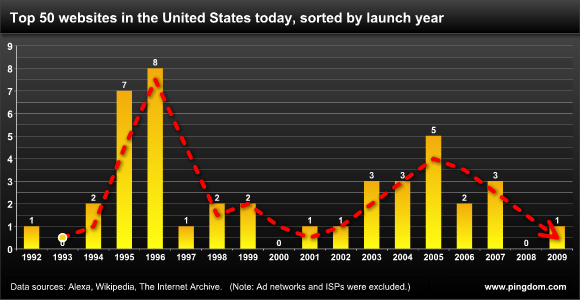How long have today’s most popular websites been around? This is a survey of when today’s top 50 websites began their lives.
What we here at Pingdom wanted to discover when we made this survey was not just how old the most popular sites are, but to see if we could discover any interesting trends based on that, and we think we did.
For the extra curious we’ve also included a table with the individual launch years for all of the top websites at the bottom of the article.

A note about site inclusion/exclusion: We based this chart on the Alexa top 50 sites in the US. We should note here that we filtered out a few sites from the top 50 because we considered them sites that people don’t normally visit. Some ad networks (like doubleclick.com) always end up in artificially high positions due to the way Alexa measures, for example. We tried to focus on websites that people actually use. After the filtering, we ended up with 42 sites (the list is available at the bottom of this article).
A few observations
Although the above chart pretty much speaks for itself, especially with the red trend curve, here are a few observations based on the data we collected.
- 43% of today’s top sites were started in 1996 or earlier.
- The three “biggest” launch years, from largest to smallest: 1996, 1995, 2005.
- The sites launched in 1995, 1996 and 2005 together account for almost 48% of the top sites.
- Fun fact: The oldest site in the current top 50 is IMDB.com, which launched on the Web in 1992. The youngest is Bing.com, launched this year.
Calculations were based on the filtered number of sites, i.e. 42. (See explanation under the chart for how we came to that number.)
Some thoughts and things to consider
The Web is still young (a teenager in human years), so it’s difficult to draw any long-ranging conclusions from the gathered data, but we can at least make some reasonable assumptions (and pose a few questions) based on it.
- The peak at 1995-1996 is when the Web really started to take off, so understandably a lot of big properties launched websites back then (including traditional media like the New York Times and CNN).
- The slump around 2000-2001 is also understandable. That’s when the dot-com bubble burst.
- Question: Was the time around 2005 an unusually creative and productive (and successful) era on the Web, or is it a matter of the cyclic rise and fall in popularity of websites? Will we in two years’ time see a peak around 2007 instead of 2005 if we perform the same survey, i.e. do most websites “peak” after around four years?
What do you think? Please share your thoughts and insights with us in the comments.
Included top 50 sites
For the curious, here is a list if the 42 sites that make up the chart, sorted by launch year:
| Site | Launch year | Alexa Rank |
|---|---|---|
| IMDB.com | 1992 | 22 |
| Yahoo.com | 1994 | 2 |
| Microsoft.com | 1994 | 19 |
| MSN.com | 1995 | 7 |
| eBay.com | 1995 | 10 |
| Amazon.com | 1995 | 14 |
| Go.com | 1995 | 15 |
| CNN.com | 1995 | 17 |
| ESPN.go.com | 1995 | 23 |
| NYTimes.com | 1995 | 28 |
| Craigslist.org | 1996 | 9 |
| Weather.com | 1996 | 25 |
| About.com | 1996 | 26 |
| Apple.com | 1996 | 29 |
| CNET.com | 1996 | 33 |
| MapQuest.com | 1996 | 34 |
| FoxNews.com | 1996 | 38 |
| Adobe.com | 1996 | 40 |
| BBC.co.uk | 1997 | 48 |
| Google.com | 1998 | 1 |
| Netflix.com | 1998 | 32 |
| Blogger.com | 1999 | 11 |
| Walmart.com | 1999 | 43 |
| Wikipedia.org | 2001 | 8 |
| Livejasmin.com | 2002 | 36 |
| MySpace.com | 2003 | 5 |
| Photobucket.com | 2003 | 21 |
| LinkedIn.com | 2003 | 27 |
| Facebook.com | 2004 | 3 |
| Flickr.com | 2004 | 18 |
| Digg.com | 2004 | 41 |
| YouTube.com | 2005 | 4 |
| home.Live.com | 2005 | 6 |
| WordPress.com | 2005 | 20 |
| Rapidshare.com | 2005 | 42 |
| Answers.com | 2005 | 49 |
| Twitter.com | 2006 | 13 |
| Youporn.com | 2006 | 47 |
| Pornhub.com | 2007 | 30 |
| Hulu.com | 2007 | 39 |
| Zynga.com | 2007 | 46 |
| Bing.com | 2009 | 16 |
Further reading: If you like Web history, here are a few additional posts you might enjoy:
- The Web back in 1996-1997
- The early buzz about some of today’s most popular websites
- How we got from 1 to 162 million websites on the Internet


























